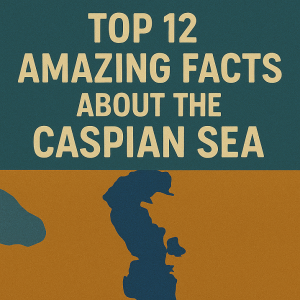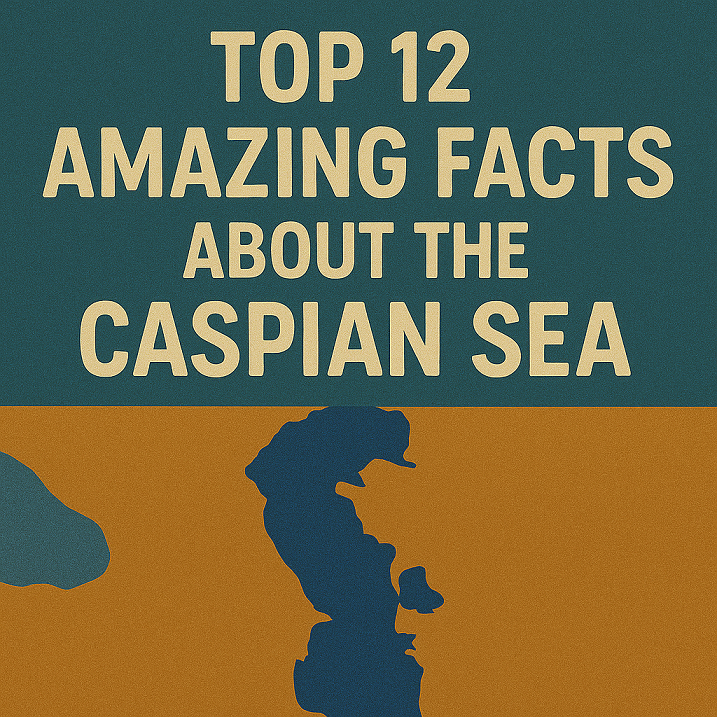Explore the top 12 amazing facts about the Caspian Sea — a body of water that defies easy classification. Discover its unique legal status, vast oil wealth, endangered biodiversity, and its growing importance in modern maritime geopolitics.

Why the Caspian Sea Still Matters in Global Maritime Affairs
Though it’s often called a “sea,” the Caspian Sea is technically the world’s largest enclosed inland body of water, covering about 371,000 square kilometers—bigger than Germany. Bordered by five nations—Russia, Iran, Kazakhstan, Turkmenistan, and Azerbaijan—the Caspian Sea holds strategic, ecological, and economic importance that ripples far beyond its shores.
This isn’t just a saltwater curiosity. For maritime professionals, the Caspian represents a unique hybrid of inland shipping, offshore drilling, naval strategy, and international law disputes. From tanker routes and pipeline corridors to sturgeon fisheries and naval deployments, this sea (or lake?) plays a critical role in Eurasia’s transport networks and energy security.
Let’s dive into 12 incredible facts that reveal why the Caspian Sea matters now more than ever.
It’s Not Technically a Sea—But a Legal Puzzle
Despite its name, the Caspian Sea is landlocked, meaning it has no direct connection to the world’s oceans. Whether it’s a lake or a sea has been the subject of decades-long legal debate. That distinction is not just academic—it determines how its resources are shared.
According to the 2018 Convention on the Legal Status of the Caspian Sea, signed in Aktau, Kazakhstan, it is treated as a hybrid: water usage follows maritime rules, while seabed division follows lake principles.
This legal grey area influences navigation rights, maritime boundaries, and hydrocarbon exploration. It’s a textbook example in many IMO Model Courses and maritime law modules globally.
It’s Home to Some of the World’s Largest Oil and Gas Reserves
The seabed of the Caspian holds a treasure trove of energy. According to IHS Markit and BP Statistical Review of World Energy, the region contains over 48 billion barrels of oil and 9 trillion cubic meters of natural gas.
Platforms, pipelines, and port expansions dominate the coastline. Key offshore projects like Azeri-Chirag-Gunashli (ACG) in Azerbaijan and Kashagan in Kazakhstan have attracted global giants like BP, TotalEnergies, Chevron, and Lukoil.
These operations raise concerns for marine pollution and safety standards, governed by frameworks inspired by IMO’s MARPOL Convention and monitored by regional environmental protocols.
A Maritime Trade Network Without an Ocean
Despite being landlocked, the Caspian Sea boasts modern ports like Aktau, Turkmenbashi, Baku, and Astrakhan, linked by river-sea vessels and overland routes.
Cargoes include grain, oil, construction materials, and cars. Goods from China pass through Kazakhstan to Aktau and cross the sea to Azerbaijan, then onto Georgia or Turkey—a route known as the Trans-Caspian International Transport Route (TITR) or Middle Corridor.
The European Commission supports this route under TEN-T corridors for energy diversification and supply chain resilience.
It’s Shrinking Like the Aral Sea
The Caspian Sea has experienced significant water level drops—nearly 7 cm per year according to Helmholtz Centre for Environmental Research (UFZ). If trends continue, water levels could fall by 9–18 meters by 2100.
This threatens coastal cities, ports, and pipelines, as well as endemic species like the Caspian seal. Climate-induced shrinkage is now monitored using ESA’s Sentinel satellites and analyzed in journals like Marine Pollution Bulletin and Ocean Engineering.
It Hosts the World’s Richest Sturgeon Fishery
The Caspian Sea is famous for beluga sturgeon, the source of high-end caviar. At one time, it produced 90% of the world’s caviar.
However, overfishing, pollution, and habitat loss have led to dramatic population declines. Today, all five Caspian states have implemented fishing moratoriums or strict quotas.
The Convention on International Trade in Endangered Species (CITES) now heavily regulates sturgeon trade, making the Caspian a testing ground for balancing economic exploitation and biodiversity conservation.
A Hotspot for Regional Naval Power
Despite lacking access to oceans, the Caspian Sea has seen an arms buildup. Russia maintains a Caspian Flotilla, while Iran, Azerbaijan, and Kazakhstan have also increased their naval presence.
Why? Control over offshore fields, exclusive economic zones (EEZs), and trade routes. Naval drills are frequently reported in Lloyd’s List Intelligence and analyzed by defense institutions like RAND and RINA.
It’s a stark reminder that maritime security isn’t confined to oceans.
Ports Are Getting Smarter
Modernization is underway at key Caspian ports like Baku International Sea Trade Port and Aktau Port, driven by digital twins, IoT, and automated logistics. These ports now compete with Black Sea and Baltic counterparts.
Digitalization projects—backed by Inmarsat, UNCTAD, and the World Bank—help optimize shipping schedules, reduce emissions, and improve cargo traceability.
These advancements are central to sustainable maritime supply chains, often discussed in Maritime Economics & Logistics and Marine Policy journals.
There’s a Pipeline Running Under the Sea
The Trans-Caspian Gas Pipeline (TCGP) has been a politically charged project intended to link Turkmenistan with Azerbaijan under the sea, and ultimately deliver gas to Europe.
Supported by the European Union, opposed by Russia and Iran, the project underscores how maritime energy infrastructure intersects with geopolitics.
As of 2024, progress remains stalled, but the Caspian’s role as a pivot in energy transit remains undiminished.
It’s a Hotspot for Environmental Risk
Oil spills, invasive species, and unchecked coastal development threaten the Caspian’s fragile ecosystem. The Tehran Convention—signed in 2003—is the first legally binding regional agreement for environmental protection of the Caspian.
However, enforcement is inconsistent. According to the Marine Pollution Bulletin, brine discharge, drilling waste, and coastal erosion remain ongoing concerns.
Classification societies like DNV and Bureau Veritas (BV) are increasingly offering marine environmental risk audits to companies operating in this sensitive region.
Ancient Maritime Heritage Lives On
The Caspian Sea has been navigated since ancient times. Persian, Arab, Russian, and Turkic civilizations all used it for trade and exploration.
Underwater archaeology projects, led by institutions like the Journal of Maritime Archaeology and UNESCO, have uncovered Bronze Age shipwrecks, early Persian ports, and naval ruins.
Today, cultural preservation efforts—often co-funded by UNESCO and local ministries—aim to document and revive this maritime legacy.
It’s a Bridge Between East and West
The Caspian is more than a sea—it’s a logistics bridge. With China’s Belt and Road Initiative (BRI) and Europe’s push for supply chain diversification, the Caspian is now part of a geo-economic corridor connecting Asia and Europe.
Its shipping and rail integration models are being studied by WMU (World Maritime University) and The Nautical Institute as examples of inland maritime intermodality.
Caspian Sea Maritime Laws Are Now a Global Case Study
The legal framework governing the Caspian is now taught in leading maritime law programs at Lloyd’s Maritime Academy, IMO International Maritime Law Institute (IMLI), and Massachusetts Maritime Academy.
Students analyze the Convention on the Legal Status of the Caspian Sea to understand hybrid legal regimes and the balance between national sovereignty and collective stewardship.
These lessons now inform policy discussions on other enclosed seas, including the Black Sea, Baltic Sea, and even Lake Victoria in Africa.
FAQ
Is the Caspian Sea really a sea?
Geographically, no—it’s a landlocked lake. Legally, it is treated partly as a sea and partly as a lake under the 2018 Caspian Convention.
What countries border the Caspian Sea?
Russia, Iran, Kazakhstan, Turkmenistan, and Azerbaijan.
Why is the Caspian Sea shrinking?
Due to rising temperatures, reduced inflow from rivers, and increased evaporation. Climate change is a major factor.
Is there marine shipping on the Caspian?
Yes. River-sea ships carry cargo between ports like Aktau, Baku, and Turkmenbashi. Goods are moved further by rail and road.
Are there naval operations on the Caspian?
Yes. Russia, Iran, and other nations maintain navies on the Caspian for resource protection and security drills.
Can the Caspian Sea connect to other seas?
It connects via the Volga-Don Canal to the Black Sea, allowing limited passage of river-sea vessels.
Conclusion
The Caspian Sea is unlike any other maritime environment. It’s not quite a sea, not quite a lake—but fully embedded in the geopolitics, trade, energy, and environmental dynamics of Eurasia.
For maritime professionals, the Caspian offers a living case study in how complex legal, environmental, and economic factors intersect. From offshore oil fields to endangered fish species, from ancient shipwrecks to smart port development—this inland sea challenges traditional maritime thinking.
As climate change, trade corridors, and energy politics evolve, so too will the importance of the Caspian Sea. Understanding it isn’t just good geography—it’s vital maritime literacy.
References
- IMO MARPOL Convention
- Caspian Convention 2018 – Full Text
- World Bank – Caspian Port Development
- Marine Pollution Bulletin – Caspian Sea Research
- European Commission – Middle Corridor Projects
- UNEP – Tehran Convention Overview
- World Maritime University (WMU)
- Lloyd’s Maritime Academy – Maritime Law Courses
- UNESCO – Underwater Cultural Heritage
- IHS Markit – Energy Data
- BP Energy Review

